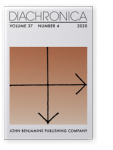Vol. 37:4 (2020) ► pp.474–513
Interrogatives as relativization markers in Indo-European
The use of interrogative pronouns as relative clause markers is often mentioned as a typical feature of European languages. This study presents an empirical approach to the distribution of interrogative pronouns as relative clause markers in time and space in the Indo-European language family. Based on a comprehensive sample of ancient and modern Indo-European languages, it is shown that interrogative-marked relative clauses are present in all stages of Indo-European within and outside of Europe. An analysis by branch suggests that this constitutes a case of parallel innovations subsequently spreading via language contact. The study also shows that interrogatives are used as relative clause markers independently of whether they are inflected pronouns or invariable markers.
Article outline
- 1.Introduction
- 2.Data collection and analysis
- 2.1Sample
- 2.2Coding
- 2.3Working definitions and concepts
- Relativization and its markers
- Interrogative
- Complementizer
- 3.Overview by branch
- 3.1Tocharian
- 3.2Indo-Iranian
- 3.2.1Indic
- 3.2.2Iranian
- 3.3Anatolian
- 3.4Armenian
- 3.5Greek
- 3.6Albanian
- 3.7Balto-Slavic
- 3.7.1Slavic
- 3.7.2Baltic
- 3.8Italic
- 3.9Germanic
- 3.10Celtic
- 4.Moving through time and space
- 5.(Non-)Correlations with other features
- 6.Conclusion
- Acknowledgements
- Supplementary material
- Notes
- Abbreviations
-
References
For any use beyond this license, please contact the publisher at [email protected].
